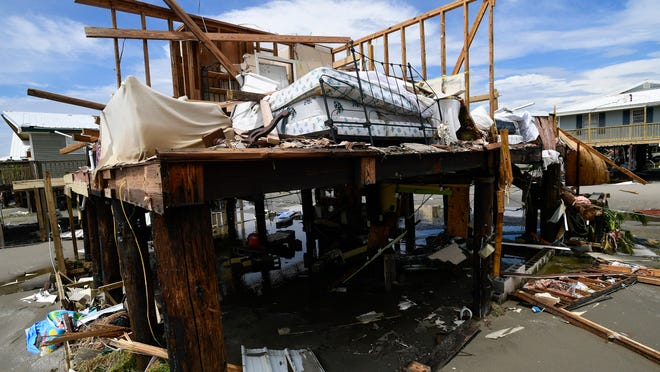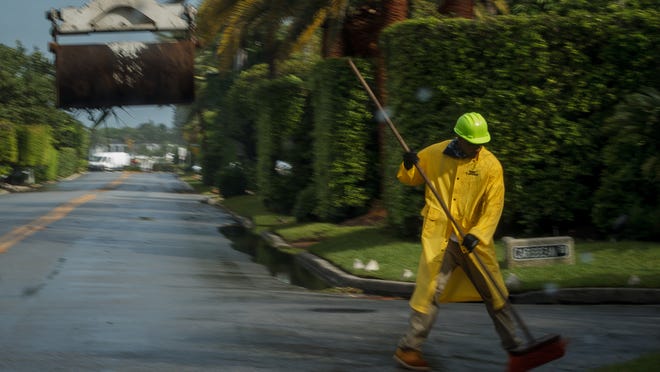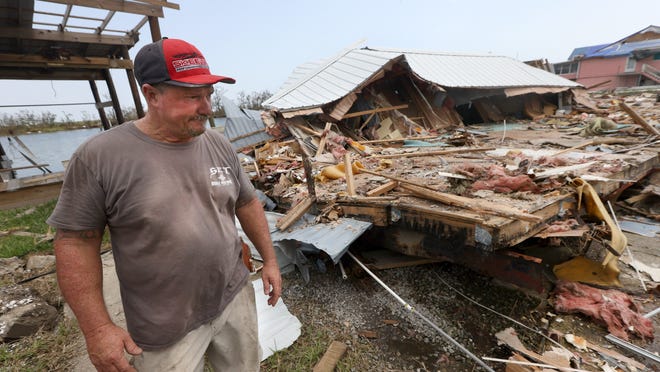
The bustling 2021 hurricane season is four storms shy of having to queue up a new list of tropical cyclone names debuted this year to replace the unwieldy Greek alphabet.
If the catalogue of novel monikers is used, it would be only the third time in seven decades of naming Atlantic basin storms that a backup list of names was needed.
With more than two months remaining in the season and La Niña on the rise, some experts said they have little doubt the traditional list of 21 storm names will be exhausted following the formation of tropical storms Peter and Rose over the weekend.
A burgeoning disturbance south of the Cabo Verde Islands was given an 80% chance over five days of gaining tropical repute. If it reaches storm strength with 39 mph sustained winds it would be named Sam. Following Sam, the remaining names on this year’s list are Teresa, Victor and Wanda.
Colorado State University’s forecast through Sept. 29 says the “large-scale pattern broadly looks to remain relatively conducive for Atlantic hurricane formation and intensification.”
“Models are showing that we should get at least average activity in the coming two weeks,” said Weather Underground co-founder Jeff Masters, who writes a storm blog for Yale Climate Connections. “Plus, climatology says we should have six more named storms this year.”
List of names for hurricane season 2021
There are six rotating lists of traditional storm names. All end with the letter W and exclude Q, U, X, Y and Z because there are fewer names that start with those letters.
In past years, the Greek alphabet was the fall back if the original list ran out. But just two previous years – 2020 and 2005 – required its use.
Ida’s power:What is a ‘brown ocean’ and how did it turn Ida into such a monster hurricane?
Big storms:Claudette was a storm the likes of which we may not see again in our lifetime
Hurricane spaghetti models:Things you need to know to track the models
The unprecedented 2020 hurricane season blew through the traditional name list in mid-September, forcing the National Hurricane Center to eventually delve nine names deep into the Greek alphabet. In the hyperactive 2005 season, six tropical cyclones earned Greek alphabet names.
An alternative list of peoples’ names – starting with Adria, Braylen and Caridad – was created in March to replace the Greek alphabet after the World Meteorological Organization (WMO) said Greek letters were too confusing and distracted from the potential perils of a storm. There was also no backup plan if a Greek alphabet name needed to be retired because it caused exceptional damage or deaths. The WMO retired Eta and Iota this year after both made landfalls in Nicaragua as Category 4 storms less than two weeks apart.
National Hurricane Center Director Ken Graham said in March that another concern with the Greek alphabet was some of the names sound too similar, such as Zeta, Eta and Theta.
Also, the Greek alphabet doesn’t follow the English alphabet in terms of order. Graham said he fielded calls from people asking what would happen when Zeta was used up.
“People were worried that was the last name,” Graham said in March. “But Z is not the end of the Greek alphabet.”
Zeta is the sixth letter in the Greek alphabet.
Emergency managers worry:Are Florida newbies ready for hurricane season?
Hurricane season 2021:Will Bermuda High offer another year of protection for South Florida?
Randy Adkins, a senior meteorologist with AccuWeather, said there’s no perfect naming solution after the initial list is exhausted.
“If we pick names from a supplemental list using A, B and C, then when we look back at the season 20 years from now we may lose track of whether it was the first A storm or the second,” Adkins said. “It could add to the level of confusion.”
The names Peter and Rose are notable in that they are both from the original 1979 list of men’s and women’s names. Before 1979, only women’s names were used for storms.
A scary trend:Major hurricanes in October and November — why is it happening?
Related:Why most of the human tragedy from hurricanes comes after the storm
This year marks the second time Peter has been used. This is the first time Rose was used.
National Hurricane Center meteorologists had fun with Rose’s forecast Monday.
“There are a lot of thorns in the way of Rose blossoming into a stronger storm,” wrote NHC Senior Hurricane Specialist Eric Blake. “At longer range, stronger shear and dry air should pull the petals off Rose one-by-one, causing the cyclone to slowly weaken.
Despite eight storms making landfall in the U.S. this season, South Florida has so far remained unscathed.
An elongated Bermuda High has served to steer storms past South Florida and into the Gulf of Mexico, but Adkins said the high has moved farther east. Tropical Storm Peter is expected to round the western edge of the high pressure mid week and then get picked up by an upper-level trough pushing into the east coast. Rose is forecast to remain far from land.
Peak of the season:Hurricane season peaked this month. Here’s why we’re not out of the woods yet
King tides:Summer’s final full moon heralds autumn and South Florida’s king tide season
AccuWeather increased its initial hurricane season prediction from an original 16 to 20 named storms to 20 to 25. Part of the increase is because of a looming La Niña, which reduces storm-shredding wind shear in the tropical Atlantic and can act to extend the active part of hurricane season.
“There is some concern in our tropical forecasting group that we could see a pulse of activity once we get later in October and into November,” Adkins said.
Hurricane season officially ends Nov. 30 with storms typically tapering off in late October.
But not always. Last year, Eta made landfall southwest of Islamorada on Nov. 8 as a tropical storm. Theta and Iota, neither of which affected the U.S., followed Eta. Iota finally ended the season when it fizzled on Nov. 18.
Kimberly Miller is a veteran journalist for The Palm Beach Post, part of the USA Today Network of Florida. She covers weather, climate and the environment and has a certificate in Weather Forecasting from Penn State. Contact Kim at kmiller@pbpost.com



